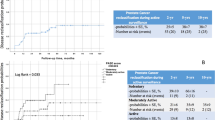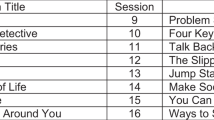Abstract
BACKGROUND:
Although much research has examined the relationship between lifestyle and prostate cancer (PCa) risk, few studies focus on the relationship between lifestyle and PCa progression. The present study examines this relationship among men initially diagnosed with low- to intermediate-risk PCa and managed with active surveillance (AS).
METHODS:
Men enrolled in two separate AS programs were recruited for this study. Data regarding clinical, demographic and lifestyle characteristics were collected. Results were then compared between men whose disease remained low- to intermediate-risk and men whose disease progressed.
RESULTS:
Demographic, clinical and physical characteristics were similar between comparative groups and cohorts, with the exception that age at the time of diagnosis and questionnaire was increased among men whose disease progressed. Lifestyle scores among men who remained low- to intermediate-risk were higher than those whose risk progressed; however, scores were only significant in one cohort on univariable analysis. On multivariable analysis, the only predictor of progression was age at diagnosis. Physical activity was consistently higher in both low risk groups, although this difference was insignificant. Consistent differences in other lifestyle variables were not observed.
CONCLUSIONS:
Age remains an important predictor of PCa progression. Improving lifestyle characteristics among men initially managed with AS might help to reduce the risk of progression. Given the limitations of this study, more rigorous investigation is required to confirm whether lifestyle characteristics influence the progression of low- to intermediate-risk PCa.
This is a preview of subscription content, access via your institution
Access options
Subscribe to this journal
Receive 4 print issues and online access
$259.00 per year
only $64.75 per issue
Buy this article
- Purchase on Springer Link
- Instant access to full article PDF
Prices may be subject to local taxes which are calculated during checkout



Similar content being viewed by others
References
Jemal A, Bray F, Center MM, Ferlay J, Ward E, Forman D . Global cancer statistics. CA Cancer J Clin 2011; 61: 69–90.
Cooperberg MR, Carroll PR, Klotz L . Active surveillance for prostate cancer: progress and promise. J Clin Oncol 2011; 29: 3669–3676.
Miller DC, Gruber SB, Hollenbeck BK, Montie JE, Wei JT . Incidence of initial local therapy among men with lower-risk prostate cancer in the United States. J Natl Cancer Inst 2006; 98: 1134–1141.
Klotz L, Vesprini D, Sethukavalan P, Jethava V, Zhang L, Jain S et al. Long-term follow-up of a large active surveillance cohort of patients with prostate cancer. J Clin Oncol 2015; 33: 272–277.
Klotz L . Active surveillance for low-risk prostate cancer. Curr Urol Rep 2015; 16: 492.
Burton AJ, Martin RM, Donovan JL, Lane JA, Davis M, Hamdy FC et al. Associations of lifestyle factors and anthropometric measures with repeat PSA levels during active surveillance/monitoring. Cancer Epidemiol Biomarkers Prev 2012; 21: 1877–1885.
Frattaroli J, Weidner G, Dnistrian AM, Kemp C, Daubenmier JJ, Marlin RO et al. Clinical events in prostate cancer lifestyle trial: results from two years of follow-up. Urology 2008; 72: 1319–1323.
Ornish D, Weidner G, Fair WR, Marlin R, Pettengill EB, Raisin CJ et al. Intensive lifestyle changes may affect the progression of prostate cancer. J Urol 2005; 174: 1065–1070.
Klotz L . Active surveillance for prostate cancer: overview and update. Curr Treat Options Oncol 2013; 14: 97–108.
Ng MK, Van As N, Thomas K, Woode-Amissah R, Horwich A, Huddart R et al. Prostate-specific antigen (PSA) kinetics in untreated, localized prostate cancer: PSA velocity vs PSA doubling time. BJU Int 2009; 103: 872–876.
Bonita R, Decourten M, Dwyer T, Jamrozic K, Winkelmann R . Surveillance of Risk Factors for Noncommunicable Diseases: The WHO Stepwise Approach. World Health Organisation: Geneva, Switzerland, 2002.
Aune D, Navarro Rosenblatt DA, Chan DS, Vieira AR, Vieira R, Greenwood DC et al. Dairy products, calcium, and prostate cancer risk: a systematic review and meta-analysis of cohort studies. Am J Clin Nutr 2015; 101: 87–117.
Tate PL, Bibb R, Larcom LL . Milk stimulates growth of prostate cancer cells in culture. Nutr Cancer 2011; 63: 1361–1366.
Mandair D, Rossi RE, Pericleous M, Whyand T, Caplin ME . Prostate cancer and the influence of dietary factors and supplements: a systematic review. Nutr Metab (Lond) 2014; 11: 30.
Chan JM, Holick CN, Leitzmann MF, Rimm EB, Willett WC, Stampfer MJ et al. Diet after diagnosis and the risk of prostate cancer progression, recurrence, and death (United States). Cancer Causes Control 2006; 17: 199–208.
Giovannucci E, Liu Y, Platz EA, Stampfer MJ, Willett WC . Risk factors for prostate cancer incidence and progression in the health professionals follow-up study. Int J Cancer 2007; 121: 1571–1578.
Giovannucci E, Rimm EB, Stampfer MJ, Willett WC . A prospective study of cruciferous vegetables and prostate cancer. Cancer Epidemiol Biomarkers Prev 2003; 12: 1403–1409.
Yan L, Spitznagel EL . Soy consumption and prostate cancer risk in men: a revisit of a meta-analysis. Am J Clin Nutr 2009; 89: 1155–1163.
Richman EL, Carroll PR, Chan JM . Vegetable and fruit intake after diagnosis and risk of prostate cancer progression. Int J Cancer 2012; 131: 201–210.
Byrne NM, Hills AP, Hunter GR, Weinsier RL, Shutz Y . Metabolic equivalent: one size does not fit all. J Appl Physiol 2005; 99: 1112–1119.
Richman EL, Kenfield SA, Stampfer MJ, Paciorek A, Carroll PR, Chan JM . Physical activity after diagnosis and risk of prostate cancer progression: data from the cancer of the prostate strategic urologic research endeavor. Cancer Res 2011; 71: 3889–3895.
Allott EH, Masko EM, Freedland SJ . Obesity and prostate cancer: weighing the evidence. Eur Urol 2013; 63: 800–809.
Ploussard G, de la Taille A, Bayoud Y, Durand X, Terry S, Xylinas E et al. The risk of upstaged disease increases with body mass index in low-risk prostate cancer patients eligible for active surveillance. Eur Urol 2012; 61: 356–362.
Su LJ, Arab L, Steck SE, Fontham ET, Schroeder JC, Bensen JT et al. Obesity and prostate cancer aggressiveness among African and Caucasian Americans in a population-based study. Cancer Epidemiol Biomarkers Prev 2011; 20: 844–853.
Moreira DM, Aronson WJ, Terris MK, Kane CJ, Amling CL, Cooperberg MR et al. Cigarette smoking is associated with an increased risk of biochemical disease recurrence, metastasis, castration-resistant prostate cancer, and mortality after radical prostatectomy: results from the SEARCH database. Cancer 2014; 120: 197–204.
Kenfield SA, Stampfer MJ, Chan JM, Giovannucci E . Smoking and prostate cancer survival and recurrence. JAMA 2011; 305: 2548–2555.
Bagnardi V, Rota M, Botteri E, Tramacere I, Islami F, Fedirko V . Alcohol consumption and site-specific cancer risk: a comprehensive dose-response meta-analysis. Br J Cancer 2015; 112: 580–593.
McGregor SE, Courneya KS, Kopciuk KA, Tosevski C, Friedenreich CM . Case-control study of lifetime alcohol intake and prostate cancer risk. Cancer Causes Control 2013; 24: 451–461.
Sawada M, Inoue M, Iwasaki M, Sasazuki S, Yamaji T, Shimazu T . Alcohol and smoking and subsequent risk of prostate cancer in Japanese men: the Japan Public Health Center-based prospective study. Int J Cancer 2014; 134: 971–978.
Kenfield SA, Batista JL, Jahn JL, Downer MK, Van Blarigan EL, Sesso HD et al. Development and application of a lifestyle score for prevention of lethal prostate cancer. J Natl Cancer Inst 2015; 108: djv329.
Tsodikov A, Szabo A, Wegelin J . A population model of prostate cancer incidence. Stat Med 2006; 25: 2846–2866.
Chefo S, Tsodikov A . Stage-specific cancer incidence: an artificially mixed multinomial logit model. Stat Med 2009; 28: 2054–2076.
Salinas CA, Tsodikov A, Ishak-Howard M, Cooney KA . Prostate cancer in young men: an important clinical entity. Nat Rev Urol 2014; 11: 317–323.
Lindstrom S, Schumcher FR, Cox D, Travis RC, Albanes D, Allen NE et al. Common genetic variants in prostate cancer risk prediction—results from the NCI Breast and Prostate Cancer Cohort Consortium (BPC3). Cancer Epidemiol Biomarkers Prev 2012; 21: 437–444.
Prince SA, Adamo KB, Hamel ME, Hardt J, Connor Gorber S, Tremblay M . A comparison of direct versus self-report measures for assessing physical activity in adults: a systematic review. Int J Behav Nutr Phys Act 2008; 5: 56.
Craig CL, Marshall AL, Sjostrom M, Bauman AE, Booth ML, Ainsworth BE et al. International physical activity questionnaire: 12-country reliability and validity. Med Sci Sports Exerc 2003; 35: 1381–1395.
Cleland CL, Hunter RF, Kee F, Cupples ME, Sallis JF, Tully MA . Validity of the global physical activity questionnaire (GPAQ) in assessing levels and change in moderate-vigorous physical activity and sedentary behaviour. BMC Public Health 2014; 14: 1255.
Souverein OW, de Vries JH, Freese R, Watzi B, Bub A, Miller ER . Prediction of fruit and vegtable intake from biomarkers using individual participant data of diet-controlled intervention studies. Br J Nutr 2015; 113: 1396–1409.
Wang J, Tang L, Wang J-S . Biomarkers of dietary polyphenols in cancer studies: current evidence and beyond. Oxid Med Cell Longev 2015; 2015: 732302.
Author information
Authors and Affiliations
Corresponding author
Ethics declarations
Competing interests
The authors declare no conflict of interest.
Rights and permissions
About this article
Cite this article
Vandersluis, A., Guy, D., Klotz, L. et al. The role of lifestyle characteristics on prostate cancer progression in two active surveillance cohorts. Prostate Cancer Prostatic Dis 19, 305–310 (2016). https://doi.org/10.1038/pcan.2016.22
Received:
Revised:
Accepted:
Published:
Issue Date:
DOI: https://doi.org/10.1038/pcan.2016.22
This article is cited by
-
Physical activity decreases the risk of cancer reclassification in patients on active surveillance: a multicenter retrospective study
Prostate Cancer and Prostatic Diseases (2021)
-
Post-Diagnostic Dietary and Lifestyle Factors and Prostate Cancer Recurrence, Progression, and Mortality
Current Oncology Reports (2021)
-
Total energy expenditure and vigorous-intensity physical activity are associated with reduced odds of reclassification among men on active surveillance
Prostate Cancer and Prostatic Diseases (2018)
-
Healthy lifestyle behaviors and control of hypertension among adult hypertensive patients
Scientific Reports (2018)



